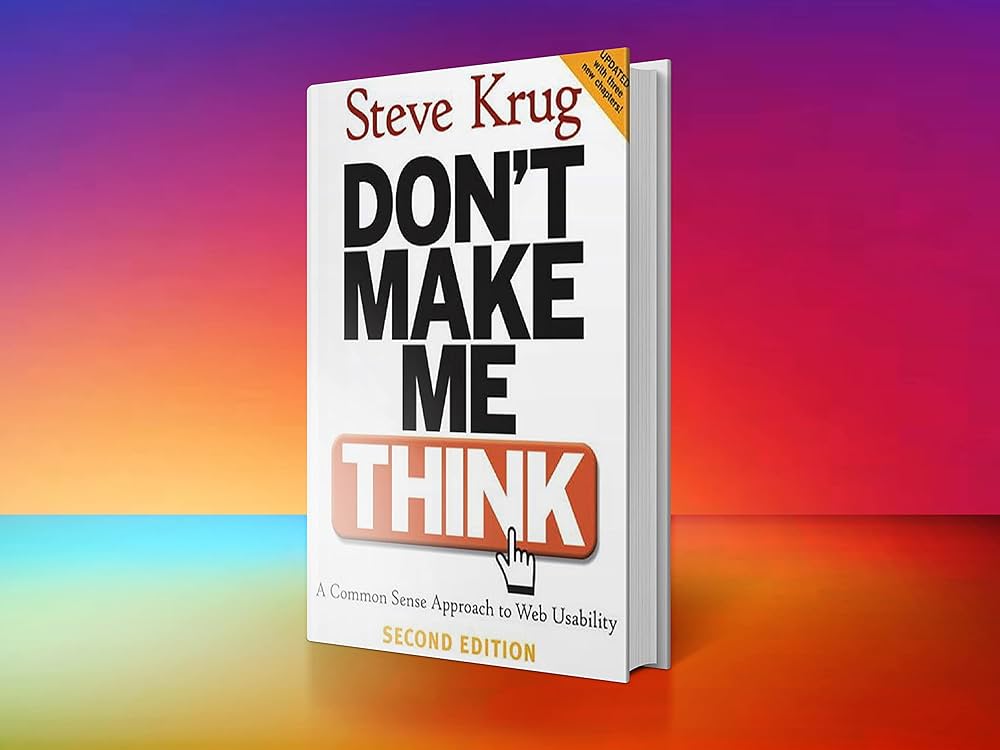Don’t Make Me Think — The UX Principle That Still Shapes Everything I Build (Even in the AI Era)
Almost 20 years ago, when I was studying UX, I picked up a small book that would end up shaping how I think about product, marketing, and user experience to this day: Don’t Make Me Think by Steve Krug.
It wasn’t a dense UX textbook. It was refreshingly direct, even obvious — and that’s what made it unforgettable.
The core idea was simple:
"If something requires a large investment of time — or looks like it will — it’s less likely to be used."
And more famously:
"The fact that the people who built the site didn't care enough to make things obvious — or even coherent — makes us feel like they don't care about us."
That mindset stuck with me — and followed me everywhere, from early design roles to leading growth and marketing at Salesforce, Samsara, Amplitude and now Webless.

Because even as I moved away from wireframes and prototypes into funnels, messaging, and ROI dashboards, one thing never changed:
If you make someone think too much, you’ll lose them.
B2B Websites Are Still Making People Think
Fast forward to today — I run Webless, and we work with B2B companies across SaaS, cybersecurity, consulting, and more.
Every single one of them has invested heavily in content.
- Dozens of solution pages.
- Thoughtful case studies.
- Long-form blogs and explainers.
- Compliance FAQs and pricing breakdowns.
All incredibly valuable. All created with care.
But here’s the problem: most of it is buried.
Ask a visitor to find a relevant customer story? Good luck.
Ask them to understand how your pricing works? That’s a spreadsheet moment.
Want them to compare product tiers or see what’s relevant to their industry? They’ll probably bounce first.
The irony?
When they finally do talk to a salesperson, they say:
“Oh wow, this is super relevant. I didn’t realize you did that.”
It’s not because your story is wrong.
It’s because it’s hidden.
It’s a UX problem — and also a delivery problem.
In fact, according to Gartner, 83% of a B2B buyer’s journey happens before talking to sales. And in that time, most buyers consume 3–7 pieces of content. But only if they can find it.
If you force them to search, scroll, and piece things together — you’re asking them to think way too much.
The Marketer in Me Tells the Story.
The UX Designer in Me Removes the Friction.
This is where my UX roots meet my marketing background.
As a marketer, I care deeply about telling the right story. As a UX designer, I care about making sure that story gets seen, felt, and understood — without cognitive load.
And that’s what we’re building at Webless.
Webless sits on your site and turns your entire content library — blogs, PDFs, product pages, help docs — into answers. Not just links. Not just search results. Actual, contextual responses to visitor questions.
So if someone types:
- Blueshift: “How does Blueshift unify data from multiple marketing tools?”
- Riskified: “What does Riskified’s chargeback guarantee actually cover?”
- ChurnZero: “Do you have any success stories from SaaS companies with high-touch onboarding?”
- Cast AI: “How much can I save if I optimize EKS workloads with CAST AI?”
- Health Launchpad: “Do you have experience helping health tech startups sell into IDNs?”
…they get clear, direct answers. And links to supporting content, in context.
They don’t have to guess where to click or dig through tabs.
And the impact is immediate.
Across customers, we’ve seen:
- 25–45% increase in visitor engagement
- 30–50% reduction in bounce
- Higher qualified leads and demo conversions
- And better internal alignment on what content is actually working
One customer told us:
“You just made our entire content library usable.”
That’s the goal. Don’t make people work for value that’s already there.
In the Age of AI, UX Is the New Marketing
We’re entering an era where UX and content delivery matter more than ever.
Generative search (ChatGPT, Perplexity, Google’s AI Overviews) is changing how people discover information.
And on your own site, people expect fast, relevant, and conversational experiences.
You can no longer rely on people browsing 5–6 pages to figure out what you do.
You need to meet them where they are — and respond like a helpful, knowledgeable teammate.
Which is why I still go back to that one simple principle:
Don’t make me think.
If your buyer has to think, dig, and translate your site — they won’t.
But if you make it easy? If you make it obvious, contextual, and tailored?
They’ll stay, they’ll convert, and they’ll come back.
That’s what we’re building at Webless.
Your Website’s Second Act Starts Now
With Webless, boost engagement, increase conversions, and cut CAC in under 30 minutes—while laying the foundation for what comes next: Generative Engine Optimization.


